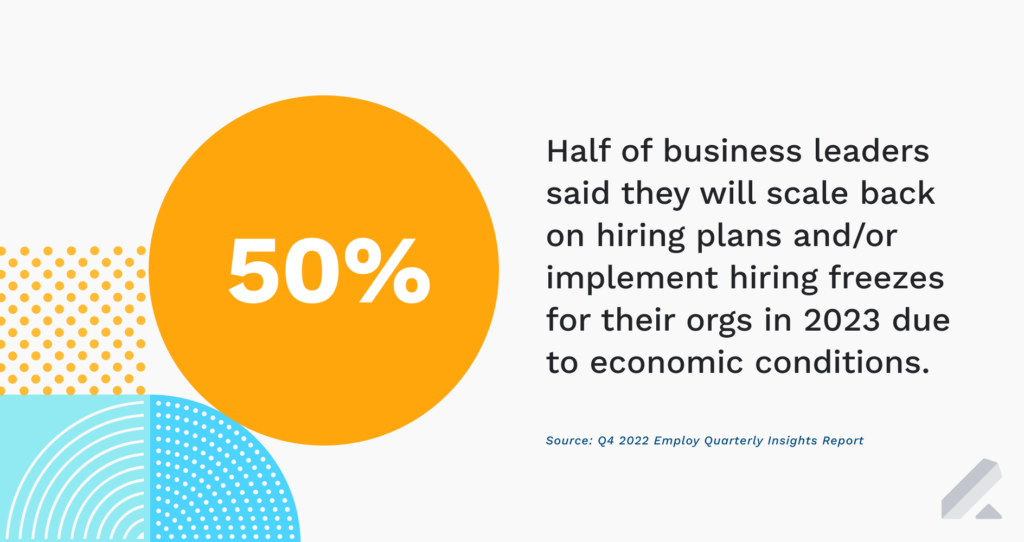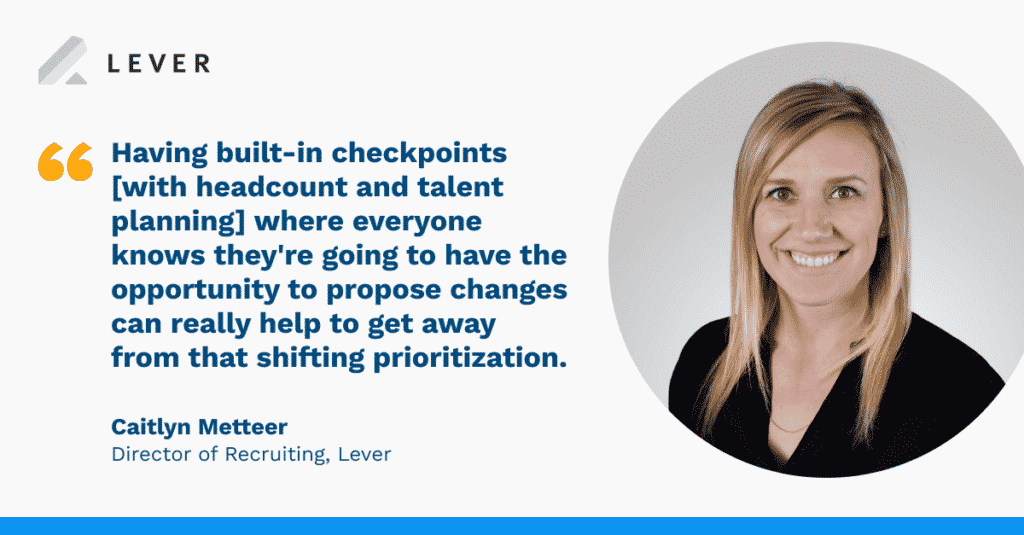Executive leaders (notably, CEOs and CROs) focus on long-term strategic workforce planning to help their companies grow and achieve their respective business objective.
While C-suites focus on the “big picture” regarding their orgs’ trajectories, HR and recruiting leaders must address near-term headcount planning.
That is, CHROs and talent directors must work closely with one another to ensure they help hire the right number of people for the teams that need them most and, in turn, contribute to short and long-terms goals for their business.
In short, today’s top talent management strategies are the ones that ensure the people with the right skill for open positions fill those critical roles.
They’re also ones that require a closely coordinated effort from HR and recruiters to:
- Address employees’ skill set gaps by offering professional development
- Enhance their employer brand through equitable and inclusive hiring
- Ensure high-performing workers are heard and recognized accordingly
- Prioritize hands-on employee engagement and talent management
- Use real-time data to realize their shared hiring plans and business goals
If you need advice and insights to help you improve in these areas to achieve your headcount and talent planning KPIs in the months and years ahead, you’ve come to the right place.
Lever Director of Recruiting Caitlyn Metteer joined CloserIQ VP Operations & Strategy Jason Lalk in a webinar to discuss how they augment their hiring processes and retain top talent.

Adjusting your headcount planning process to account for external forces and remote work
The global pandemic. Ongoing supply-chain issues. General volatility in the modern business climate. There are many external factors that have impacted HR and recruiters’ joint efforts to hire high-quality candidates and bolster their retention strategies and succession planning.
Because of these factors, the tables have turned within the job market.
“It became a very different recruiting landscape [in the last couple of years],” per Jason. “We went from a candidate-driven market to a company-driven market overnight. Now, we have demand that is probably 3-5x what we had going into the pandemic.”
Due to high competition for a sparse selection of quality candidates, Jason said it’s vital for HR and recruiting to work to retain top performers and prevent employee attrition.
One way those responsible for headcount planning do this today, per Jason, is focusing on better meeting prospects’ needs and preferences regarding salary, skill gaps they want to rectify, and where they want to work.
“Figuring out what those remote [work] options look like [at your business] is going to be really important, because the appetite is still there [among candidates] and it’s going to be there for a while,” Jason stated.
Jason added prospects he speaks with increasingly request to “work anywhere,” noting “it’s just a reality we’re going to have to accept” and that companies’ organizational structure will invariably feature both in-office and “WFH” staff members.

“Quick-start” headcount planning a key way to help stay ahead of your org’s talent needs
Caitlyn relayed these prospect preferences must not only be addressed on a case-by-case basis with candidates, but — in addition to factoring in external factors like COVID — also accounted for in your company’s end-of-year headcount and talent planning for the next year.
“One of the challenges we’ve seen is this sort of chicken-egg situation where you’re working on your annual plans, and so teams might not feel confident in their total ask for headcount until those plans are finalized,” Caitlyn explained during the webinar.
In 2021, Caitlyn detailed how the Lever recruiting team had a “quick-start” plan in place for Q1 2022 well before 2021 ended (around the third quarter, she noted).
This plan “allows our team to start on roles we know we’re going to need, so we can at least get working on that plan and have the most important building blocks in place to help us contribute to company goals, Caitlyn added.
Caitlyn said this quick-start plan enables the Lever TA team to “get a head-start [on filling roles] without forcing things to be completely locked in” to a set-in-stone hiring strategy.
As for the WFH component, Caitlyn said Lever listens to candidates to know what each wants from their prospective work experience and accommodate new hires as best we can.
“We decided to go with a really flexible return-to-work plan, even when we do have offices reopen,” said Caitlyn. “We’re really hearing from candidates they want that flexibility.
“Some people are really invested in and excited about eventually going back to an office. Some people we speak with are like, ‘I’m never set stepping foot in an office again.’ So being able to appeal to all of those folks I think is is really helpful.”

Flexibility and agility essential to best execute (and gradually enhance) your talent planning
By not having a rigid headcount and talent planning approach, Caitlyn said it becomes easier for CHROs and their counterparts in talent acquisition/recruiting to adapt as needed.
“We have an agreed-upon cadence with which we look at the [headcount] plan,” Caitlyn revealed. “Things change, and you have to have a level of flexibility” with your hiring processes.
That said, if things change daily or weekly, “it’s really hard to actually execute.” That’s where built-in, regulary “checkpoints” can help.
These checkpoints allow the C-suite, hiring managers, and/or other key stakeholders involved with hiring to propose changes to the hiring roadmap and help them “get away from [constantly] shifting prioritization, which … can make you really spin your wheels.”
Jason and his colleagues at CloserIQ now have a similar approach to ensure their headcount and talent planning efforts changed as business conditions, and/or objectives changed.
Specifically, Jason said the company shifted to “milestone-driven” planning. “You have to figure what that goal is, then reverse-engineer off that,” per Jason.
“If you’re hiring for sales, you need to think about the different revenue benchmarks that you’re planning to hit and build a team accordingly,” said Jason.
“But it’s not just, ‘I need this many reps to hit this much in sales.’ It’s, ‘I need my reps to be fully ramped by this time, and this is my expected revenue I’ll get from that number.”
This kind of careful thinking and execution regarding their hiring efforts — and accounting for specific milestones at each stage of the recruiting funnel — leads to smarter hiring, per Jason.
Watch our talent planning webinar learn how to execute a headcount planning strategy that helps you better scale your hiring and retain employees in the coming years.


